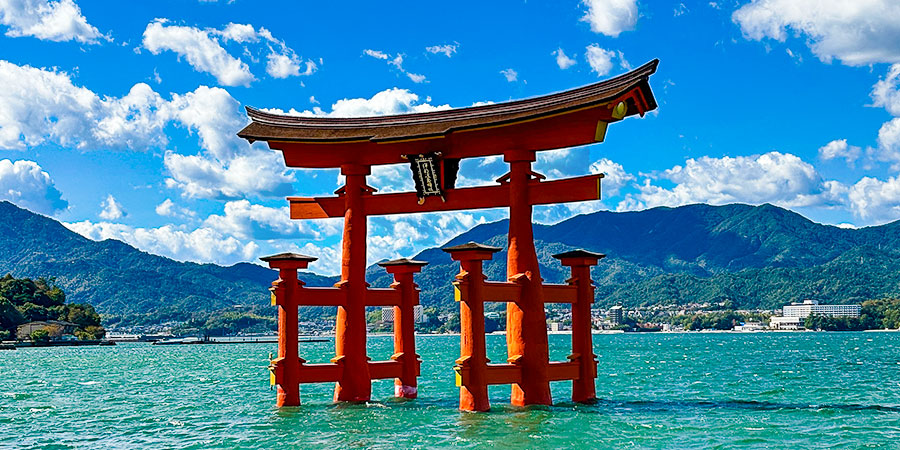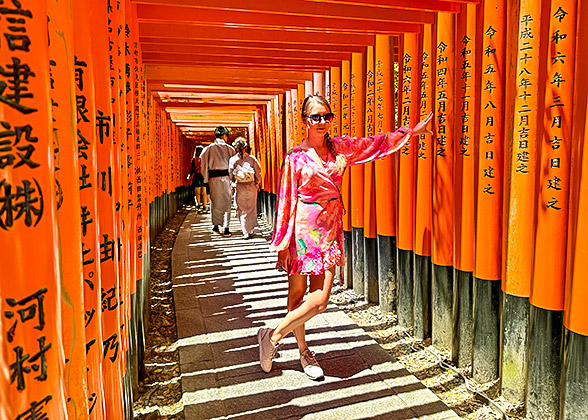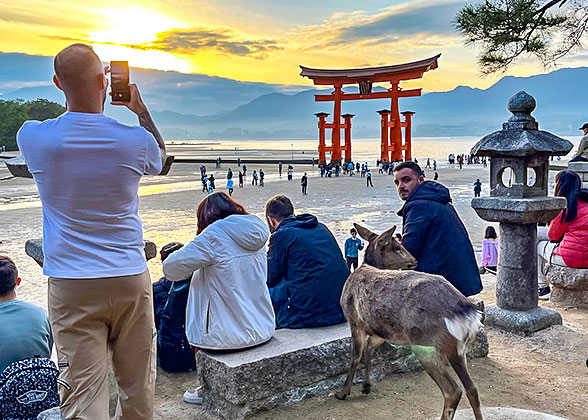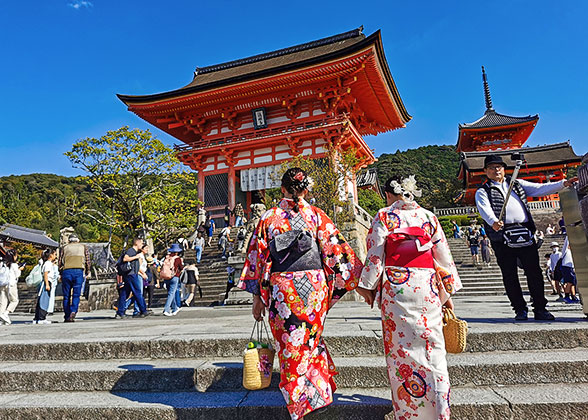Itsukushima Shrine
The Guardian of Japan’s First Military Leader
In Japanese Shinto myths, Itsukushima Shrine was selected as the base of three Shinto goddesses responsible for protecting the imperial family, the nation, and seafarers. Its history can date as far back as to 593 AD.Fast forward to the late Heian period (794 - 1185), when Taira no Kiyomori established himself as the first military leader of Japan. And it’s the victories over pirates off Miyajima Island that led to his rise, and the marine trading with Song-dynasty China that made them rich; no wonder Kiyomori would worship the goddesses to a point that he later expanded the holy grounds to a greater scale we see today.
It’s worth mentioning that, not only Itsukushima Shrine is holy, but the entire island of Miyajima is deemed so. To show respect, there are even customs to keep it from blood and death, namely childbirth and burial.
Otorii, the Celestial Entrance Floating on Water
Taking advantage of tidal ebbs and flows, Otorii gate, rising above the sea bed, seems to float on water each time the tide flows in. Its majesty, against the peacock blue of sea water and profound greenness of mountains in the distance, would enchant every beholder of it. It’s a man-made miracle, revealing the wisdom and bold imagination of Japanese ancestors.16 meters (52 feet) tall, 24 meters (78 feet) wide, the giant Otorii was made of raw camphor wood during the Heian era. It solitarily stands there 200 meters (656 feet) from the main shrine grounds, all on its own without any foundation. It’s said the gate was built to invite other sea gods in. At low tide, visitors can walk to the gate, touch it, and examine the inscriptions on the pillars.

Itsukushima Shrine Photos ( 19
|
Into the Divine World of Itsukushima Shrine
Sitting on the axis of the premises, the main shrine of Itsukushima Shrine and its sub-buildings are connected with a 273-meter (896-feet) east-west corridor. To make the most of your pilgrimage to the shrine, you might want to explore each of them for some hidden gems. Almost all are either National Treasures or Important Cultural Properties.

The floating Itsukushima Shrine while being refurbished
|
The Route to Follow
Omtesando approach → Stone torri gate → Marodo Shrine → Asazaya Hall → East Corridor → Main Shrine and Takabutai Stage → Daikou Shrine → Tenji Shrine → Noh Stage → West Corridor → Soribashi Bridge → ExitWhat to Expect at Itsukushima Shrine?
![]() Omtesando approach: Omtesando is a popular shopping street leading to Itsukushima Shrine from the Miyajimaguchi Port. It’s where to find Miyajima’s specialties.
Omtesando approach: Omtesando is a popular shopping street leading to Itsukushima Shrine from the Miyajimaguchi Port. It’s where to find Miyajima’s specialties.
|
|
|
![]() East Corridor: A zigzag National Treasure for a stroll. The bronze lanterns hung from above on either side are replacements of former iron ones that had been eroded by sea winds; same for West Corridor. You can also look to the west to find a five-storied vermillion pagoda, which soars up behind the sub shrine of Marodo.
East Corridor: A zigzag National Treasure for a stroll. The bronze lanterns hung from above on either side are replacements of former iron ones that had been eroded by sea winds; same for West Corridor. You can also look to the west to find a five-storied vermillion pagoda, which soars up behind the sub shrine of Marodo.
|
|
|
![]() Main Shrine and Takabutai Stage: The Main Shrine and Takabutai stage in front of it sit on the axis of the shrine grounds, so does Otorii gate. A symmetrical view with Otorii right in the middle can be viewed here.
Main Shrine and Takabutai Stage: The Main Shrine and Takabutai stage in front of it sit on the axis of the shrine grounds, so does Otorii gate. A symmetrical view with Otorii right in the middle can be viewed here.
|
|
|
Immerse in Festivals
Festivals give life to Japanese shrines. Visitors coming in June might not miss a festival called Kangen-sai, the most spectacular of Itsukushima Shrine. It’s held on June 17 of the lunar calendar, lasting from late afternoon until midnight. There will be big boats floating before the shrine on which people play court music with Japanese instruments, a tradition created by Kiyomori to pay tribute to the goddesses. At this time, you can find a full moon and Otorii gate standing on water.Here is a list of festivals worth participating at the shrine or on Miyajima.
| Date | Festivals |
|
2nd weekend in February |
Oyster Festival: Feast on one of Miyamaji's specialties - oyster. |
|
Late March |
Kiyomori Festival: Watch a grand parade of people dressed like the Taira family in costumes, in memory of Kiyomori. |
|
March - April |
Hina Doll Festival: Appreciate Japanese traditional dolls displayed at a number of locations on the island. |
|
April 15 |
Toka-sai: Watch court dance at Itsukushima Shrine |
|
April 15 |
Fire Walking Ceremony: A Buddhist rite to watch priests walking on coals while chanting for health and fortune, in Daishoin Temple. (Also held on November 15) |
|
April 16 – 18 |
Shin-noh: Watch Japanese traditional dance-drama performances on Noh Stage |
|
June 17 of the lunar calendar |
Kangen-sai |
|
October 15 |
Kikka-sai; Watch court dance at Itsukushima Shrine. |
|
November 3 |
Fire Walking Ceremony: A Buddhist rite to watch priests walking on coals while chanting for health and fortune, in Daiganji Temple. |
|
December 31 |
Chinka-sai; In the evening, watch locals carrying torches before Itsukushima Shrine and join locals to bring back ember as amulet to prevent fire. |
Other Activities on Miyajima to Add to Fun
![]() Interact with deer. Deer roaming the coastline of Miyajima are also part of what makes this island so attractive. Stroll with them and take pictures, but please don’t feed them as it’s not allowed here.
Interact with deer. Deer roaming the coastline of Miyajima are also part of what makes this island so attractive. Stroll with them and take pictures, but please don’t feed them as it’s not allowed here.

Deer roaming Miyajima island
|
Know Before Going
Opening hours (Open all year round):January 1: 12 am – 6:30 pm
January 2 - 3: 6:30 am – 6:30 pm
January 4 until end of February: 6:30 am – 5:30 pm
March until October 14: 6:30 am – 6:00 pm
October 15 – November 30: 6:30 am – 5:30 pm
December: 6:30 am – 5:00 pm
Admission fee: 300 yen
How to Get There?
From JR Hiroshima Station by train and ferry:Take Sanyō Honsen Line to Miyajimaguchi Station, walk to Miyajimaguchi Port, ferry (10 minutes, 200 yen one way) to Miyajima Island.
From Peace Memorial Park by direct boat:
If you plan to visit Peace Memorial Park first, you can take a direct boat from the park to Miyajimaguchi Port. Note that this may cost you 45 minutes and 2,200 yen one way.
See more:





